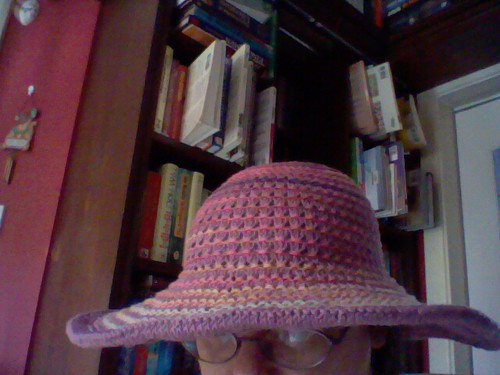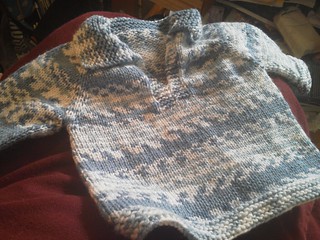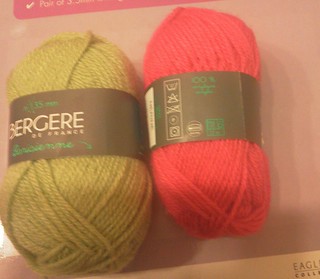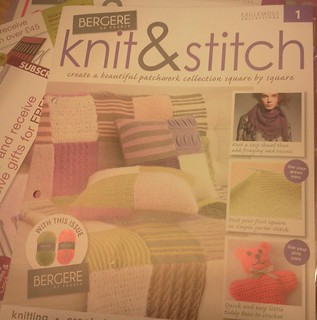Knitter's Book of Yarn
Book Depository Dublin City Public Libraries
The Knitter's Book of Yarn - Clara Parkes
0307352161/9780307352163
I was about 20 pages in when I thought about buying it and by about 60 I had an order into the Book Depository for it. I will admit that the patterns don't really fire me with huge enthuiasm but the information in this book is gold.
Yes, other authors have written on this theme, but Clara is like being in a good yarn shop with a friend who is very knowledgeable and who doesn't have a huge bias against pretty much any yarn, she sees the utility in almost every yarn and wants to share her enthuaism for it all.
The book opens up with an exploration of different fibers, starting with Protein fibers - wool, alpaca, silk etc; Cellulose Fibers - made from cotton, Linen, hemp etc; Celluostic - using industrial processes to create a fiber but deriving from natural materials like wood, bamboo, corn etc and then synthetic - nylon, acrylic etc. She discusses the pros and cons of all the fibers.
Then the book moves on to production and I finally understand the difference between worsted and woolen spun.
Then the patterns, they are divided by ply, to encourage exploration of how this works with the yarn.
Starting with single ply yarns, there are the Maine Morning Mitts; Cabled Tea Cozy, honeycomb hat and Seascape Bolero. The mitts are ribbed and pretty plain, the Tea Cozy is a good use for a small amount of luxury yarn and the honeycomb hat plays with textural stitches to create an interesting play with light. The Seascape Bolero is not my aesthetic, I just don't like the way it sits and I think the buttons on the back would interfere with my comfort.
The next are two-ply yarns; Step ribbed stole in two different texture yarns; Baby Soft Cardigan; Optic Waves Shawl; Raspberry Rhapsody scarf; Vines Cardigan; Guernsey socks; Little Shells Socks; Endpapers Shawl and double thick mittens. I like the pattern on the double thick mittens, simple but interesting; endpapers shawl shows an interesting use of some handpainted yarns and colour graduation; Little shells has texture from the ankle up; Guernsey socks are interesting textured again showing variation; Vines cardigan is an angora piece, not my thing, not into fluffy, the style is interesting and I could be tempted to knit it in a less fluffy yarn the Raspberry Rhapsody scarf is relatively simple but a nice showcase for a yarn; Optic waves uses the variegations in the yarn to accentuate the waves in the pattern. Baby Soft cardigan is for 3-24 months and is cute. The step Ribbed Stole would be a good piece against busier pieces.
Three ply yarns are the next logical step; opening with the Rhinebeck hat and Mitts, colourwork enters the game, using a variegated yarn with a plain to create a fair isle style. I like elements of the Cabled Swing Cardi, the collar doesn't work for me, I'd be tempted to tweak. Swirly o socks have a fairly simple pattern that would work with a lot of multi-coloured yarns.
Four-ply and more is next. Beginning with a very simple baby hat; then more colourwork in the Norwegian Snail Mittens, which are playful and cute. The Patchwork Carriage blanket works with stripes and textures. The girly tee uses hemp and is an interesting fairly plain pattern; two catnip toys make an appearance. Iris side-to-side sleeveless top is grafted together and then edged with vertical stripes. Ripple and lace leaf linen basket liners have an interesting texture, deceptively plain they would make a nice gift. Princess Mitts are wrist warmers with a cabled back, ideal for a small amount of luxury.
Then we move to cabled yarns, plied yarns plied on themselves. Wavy socks use cables in a loose way to create interesting movement. XOX vest is a tank top with cable detail down the middle and is a temptation for me to knit. Cabled Headband is pretty and useful, the butterfly mobius is an interesting piece for some luxurious yarn.
Textured yarns are up next. The chunky winter set uses a thick and thin yarn to good effect, the Architect's hat plays with colourwork and slip stitches in interesting ways. Diamonds and pearls shawl uses the strengths of the yarn involved to create a pretty piece.
Bouchle yarns has a honeycomb bag again using slip stitches for a colourwork pattern that compliments the yarn
Brushed yarns has a scaruffle that shows how two different yarns can produce two subtly different results.
Chenille uses a cotton chenille to produce a classic washcloth that looks lush.
The felt factor has a very pretty Calla Lily personal security nightmare bag. No way to fasten it but it's pretty. The retro cloche is a small hat that pearches on your head and I would hate it.
Then she discusses care of fabrics and some other information. There are a few errata
The book is a great resource of information and useful knowledge and I look forward to it being part of my collection.
This book was obtained from Dublin City Public Libraries where I work. Dublin City Public Libraries pay my wages but offer me no inducements to write these reviews.








